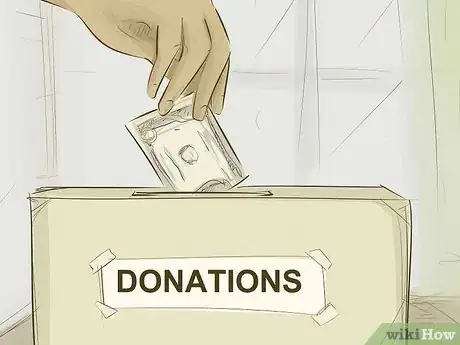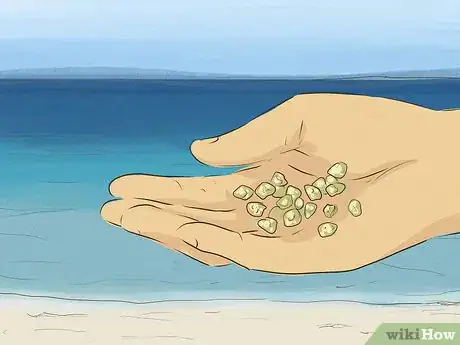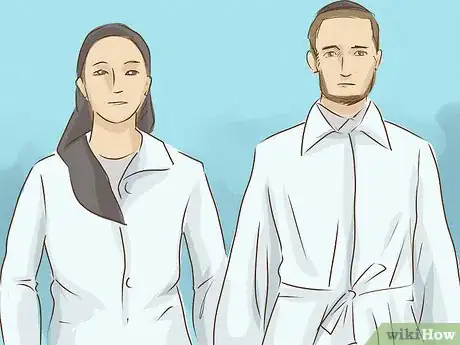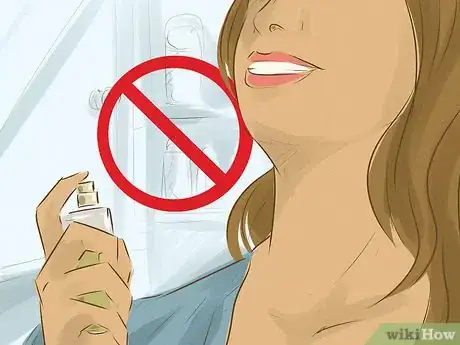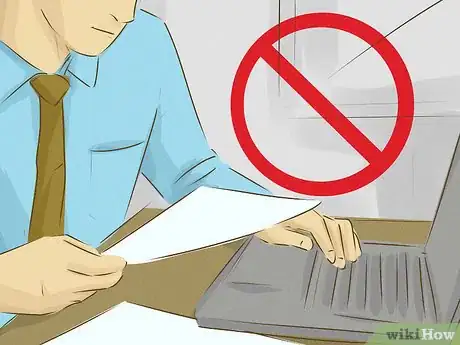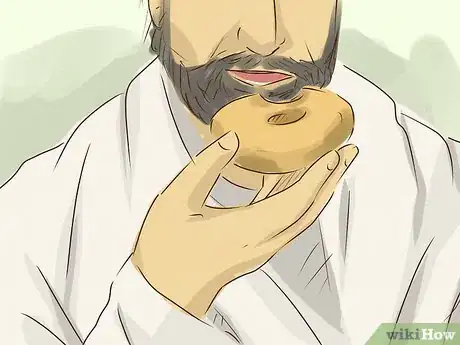This article was co-authored by wikiHow Staff. Our trained team of editors and researchers validate articles for accuracy and comprehensiveness. wikiHow's Content Management Team carefully monitors the work from our editorial staff to ensure that each article is backed by trusted research and meets our high quality standards.
There are 7 references cited in this article, which can be found at the bottom of the page.
wikiHow marks an article as reader-approved once it receives enough positive feedback. In this case, 96% of readers who voted found the article helpful, earning it our reader-approved status.
This article has been viewed 61,163 times.
Learn more...
Yom Kippur is the “Day of Atonement,” the holiest day of the year in Judaism. Celebrated 10 days after the first day of Rosh Hashanah, it's a day of atonement and repentance that also features a lot of joy and communal festivities. The date of Yom Kippur in the Gregorian calendar changes every year, ranging from mid-September to October. There are many customs and rituals involved in celebrating Yom Kippur, including before, during, and after the day itself. Fortunately, once you know what these traditional practices are, you can easily celebrate this Jewish holiday.
Yom Kippur 2023 is from the evening of Sunday the 24th of September to the evening of Monday the 25th of September.[1]
Steps
Celebrating before Yom Kippur
-
1Pray to God and repent during the 10 Days of Repentance. Ask God to forgive your sins and transgressions during the week before Yom Kippur, which is known as the 10 Days of Repentance. Although prayer and repentance are always important, this time period is considered especially important for asking forgiveness from God.[2]
- The first step in atonement is acknowledging your wrongdoing. Acknowledge and admit to your sins during your prayers.
- Jews typically conduct prayers 3 times a day, in the morning, afternoon, and evening, during synagogue services. Many temples will also hold additional services for extra prayers during the 10 Days of Repentance.
- Spend some extra time reading and studying the Torah during this time, as well.
-
2Ask forgiveness from people and forgive those who’ve wronged you. Part of practicing atonement during Yom Kippur is to acknowledge wrongs that you’ve committed, reach out to the people you owe an apology to, and sincerely beg their forgiveness. At the same time, be willing to forgive people who’ve wronged you as a way of letting go of past grudges.[3]
- If the other person still holds feelings of resentment after you've given your apology, then it's in God's hands; you have adequately atoned once you’ve sincerely apologized.
- If you’ve wronged somebody, be sincere and honest about what you did and how you feel about it. Be equally sincere in your apologies.
Advertisement -
3Give to charity so that you can be free of sin. Another act of atonement is to donate to charity or to your synagogue. This is not only an act of kindness, however; your sins are ritually transferred to whatever you donate, meaning that the act of donating renders you free of your sins.[4]
- This ritual is known in Hebrew as “kapparos.”
- If donating money isn't plausible for you, lots of people opt to donate their time instead. Volunteer at your local soup kitchen and wherever else you could serve the less fortunate.
-
4Perform the tashlich ritual to purify yourself of sin. Tashlich, meaning “cast off,” is a customary atonement ritual in which a person throws bread crumbs into the sea or a large body of water. The bread crumbs symbolically represent your sins, making the act of throwing them into the sea a way of symbolically casting away your sins.[5]
- You can perform the tashlich ritual any time before Yom Kippur, as long as you don’t do it on the actual day of Yom Kippur.
- Some customs also allow for pebbles to be used in the tashlich ritual instead of bread crumbs.
-
5Eat festive meals the day before Yom Kippur and light holiday candles. Since people fast during Yom Kippur, the day before Yom Kippur is set aside for eating 2 large, festive meals with family in the afternoon and the evening. At the conclusion of the second meal, have women in the family light candles to commemorate the coming of Yom Kippur.[6]
- Yom Kippur officially begins at sundown on this day, so this is when you should light your holiday candles.
- If there are no women in the house to light the candles, the head of the household can do this instead.
- For the lunch meal, many Jews eat a hearty meal, featuring dishes like vegetable soup, chicken, and potatoes. For the dinner, practitioners commonly eat a high-carb dairy dinner, including dishes like eggs and whole wheat bagels.
Following Traditional Practices during Yom Kippur
-
1Wear white throughout Yom Kippur as a symbol of purity. Any white clothes will do, though some Jewish men will specifically wear a kittel, a white robe in which the dead are traditionally buried. Since white is a symbol of purity and Yom Kippur revolves around spiritual cleansing, it’s an appropriate color for the occasion.[7]
- Note that whatever clothes you wear should not conflict with any of the customary restrictions people practice during Yom Kippur.
- Many Jewish men also wear a prayer shawl during Yom Kippur, known as a “tallit.”
-
2Practice the customary restrictions. During Yom Kippur, there are certain lifestyle restrictions Jewish people observe to show atonement during the high holy days. These include abstinence from applying oils or perfumes to the body, bathing, wearing leather or any animal products, engaging in sexual activities, and eating and drinking.[8]
- Practicing these restrictions is known as “afflicting the soul” and is meant to encourage atonement and humility.
- Note that children and sick people who may suffer serious harm from engaging in these restrictions are not encouraged to perform them.
-
3Refrain from doing work so you can devote your day to prayer. Yom Kippur is known as “the Sabbath of Sabbaths,” so the rule against working on Shabbat also applies during this holy day. Instead, spend this time engaged in prayer, ideally at a temple or synagogue, introspection, and repentance.[9]
- The 1 exception to the prohibition on work during Yom Kippur is for the blowing of the Shofar horn, which marks the end of Yom Kippur.
-
4Attend the 5 prayer services in a synagogue. Because of its holy status, Yom Kippur is the most popular day in Judaism for attending temple. Most temples hold 5 prayer services during this day (instead of the usual 3), where practitioners can go for congregation-wide prayer and community.[10]
- These prayer services are known as “Maariv,” “Shacharit,” “Musaf,” “Minchah,” and “Neilah.” The Neilah service is held at sunset and marks the end of Yom Kippur.
-
5Break your fast at sunset with a festive meal. The feast held at the end of Yom Kippur often consists of rich foods like bagels, souffles, sweet kugel, eggs, and cheese. Many people also prefer dairy-based dishes (rather than meat-based dishes) because they find them to be easier to digest on an empty stomach.[11]
- Bagels with cream cheese and lox are an American and Israeli favorite, but Sephardic Jews tend to eat cakes and sweet blintzes.
Community Q&A
-
QuestionWhy is Yom Kippur celebrated?
 Community AnswerRosh Hashana and Yom Kippur are the two holidays in the Jewish New Year. Rosh Hashana is more of a celebratory holiday, while most people use Yom Kippur to reflect on the past year.
Community AnswerRosh Hashana and Yom Kippur are the two holidays in the Jewish New Year. Rosh Hashana is more of a celebratory holiday, while most people use Yom Kippur to reflect on the past year.
Warnings
- Even though fasting is done on Yom Kippur, don't do it if you have health issues or if your body simply can't cope with fasting. Judaism forbids fasting if it endangers your health!⧼thumbs_response⧽
References
- ↑ https://www.chabad.org/holidays/JewishNewYear/template_cdo/aid/671893/jewish/When-Is-Yom-Kippur-in-2022-2023-2024-and-2025.htm
- ↑ https://www.chabad.org/library/article_cdo/aid/4826/jewish/10-Days-of-Repentance.htm
- ↑ https://www.chabad.org/library/article_cdo/aid/995354/jewish/How-to-Observe-Yom-Kippur-2018.htm
- ↑ http://www.holidayscalendar.com/event/yom-kippur/
- ↑ http://www.holidayscalendar.com/event/yom-kippur/
- ↑ https://www.express.co.uk/news/world/1019474/yom-kippur-2018-greetings-celebrate-yom-kippur-what-to-do-holy-day
- ↑ https://reformjudaism.org/yom-kippur-customs-and-rituals-0
- ↑ https://www.chabad.org/library/article_cdo/aid/995354/jewish/How-to-Observe-Yom-Kippur-2018.htm
- ↑ http://www.holidayscalendar.com/event/yom-kippur/


